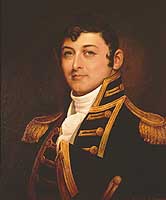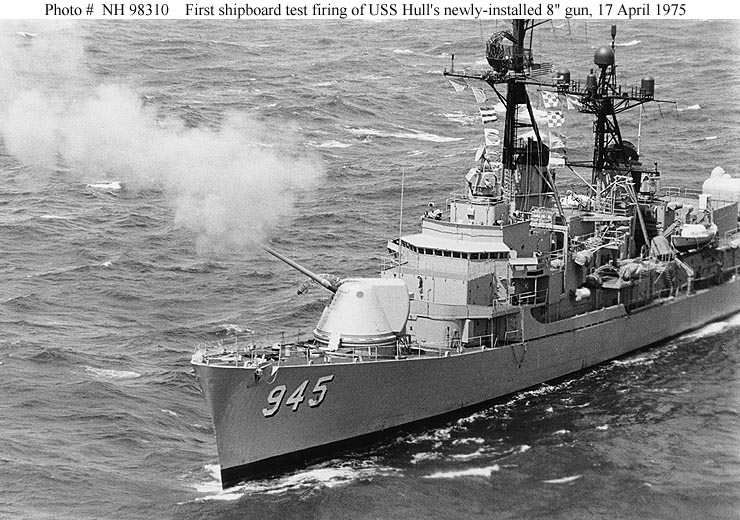Monday Maritime Matters
September 3rd, 2007 by xformed
Before you begin: Don’t forget Eagle1’s Sunday Ship History!

Captain Hull, I find was present at many more significant battles in our early history as a Nation than just as the Captain of the USS CONSTITUTION during the famous battle against the HMS Guerrière’s on August 19th, 1812. Born in Derby, CT on March 9, 1773, he was the son of a mariner and regularly accompanied his father to sea for local and longer distance sailings to the West Indies. HIs father died while he was young , and he was adopted by his uncle, William Hull, a veteran of many battles of the Revolutionary War.Beginning his own life at sea as a merchant sailor, Issac Hull had commanded several merchants ships during the 1790s, losing some to the French.
Earning a commission in the young Navy in 1798 as a Lieutenant, he served the US Navy for many years to come.His first assignment was aboard the USS CONSTITUTION. As a result, he would have seen action in the Western Atlantic during the Quasi-Wars with France.
In 1805, Isaac Hull was the captain of the USS ARGUS in the Squadron commanded by Commodore James Barron, stationed in the Mediterranean during the Barbary Wars. Here we see Lt. Issac Hull becoming part of the legendary beginnings of the US Marine Corps. The ARGUS was tasked to deliver William Eaton, an secret agent for the US, along with 8 Marines and supplies to Egypt, in a mission that would begin the US’ first land war on foreign soil. One of the Marines embarked on ARGUS was Lt Presley O’Bannon. On April 27th, 1805, after Mr. Eaton had raised an Arab and Christian Army to help get Hamet Karamali back into power in Tripoli (now Libya) and marched west to the outskirts of Derna, the USS ARGUS, accompanied by USS NAUTILUS (Lt O.H. Perry commanding) and USS HORNET, with now Master Commander Hull in command, provided naval gunfire support, while Eaton, O’Bannon and their army stormed the city from landward.
Certainly, Master Commandant Isaac Hull played a significant role in making the history we know of the Barbary Wars, as well as his later exploits as Captain of the USS CONSTITUTION. In the early days of the War of 1812, sailing from Annapolis in July after re-coppering the bottom of CONSTITUTION, Capt Hull almost lost the ship to a far superior force of an entire British Squadron, comprised of 4 frigates and a 64 gun battleship. The story of the escape from enemy forces is told in “Six Frigates” by Ian Toll, in great detail. Not having the wind to retreat, the crew put the boats in the water and used kedge anchors and the ship’s capstans to pull the ship away from the British. For three days, the becalmed warships fought for any slight advantage, yet remained out of effective gunfire range of one another. The crew of the CONSTITUTION did not rest the entire time, being needed to row, man guns, or the capstan bars to save themselves and their ship.
A month later, Captain Hull would show his skill as a warship skipper, soundly beating Captain Dacares of the HMS Guerrière’s, one of the ship’s that had hounded CONSTITUTION in July.
Captain Hull went from the CONSTITUTION to command the Portsmouth Navy Yard at Kittery, ME, where the construction of the USS WASHINGTON, the US Navy’s first 74 gun battle ship was begun. This, it seems, was a task fit for someone with courage and constitution for battle. from the website SeacoastNH:
When Hull arrived at the new federal yard he discovered a miniscule facility with only a few buildings, not a single guard or defensive cannon and just 18 men.
Isaac Hull was unshaken. He had done the impossible before. A year before, pursued near New Jersey by five ships from the world’s finest navy, Hull gave the British fleet the slip. Then with the American fleet outnumbered 100 ships to one, he pitted the USS CONSTITUTION dead against HMS GURRIERE outside Boston in August 1812. When the smoke cleared, the American ship had won the battle, puncturing the Royal Navy’s claim to invincibility. It was largely a morale victory, but just the boost a politically divided young country needed. His surviving ship became known as “Old Ironsides”.
Still the War of 1812 raged on. Before it was over the British would torch the new nation’s capital city of Washington. Even as Washington burned, Hull was building the USS WASHINGTON, the name eventually assigned to his 74-gun project. Despite the crude shipbuilding conditions there, Hull’s initial assessment of Portsmouth Harbor vibrated with enthusiasm. He highly approved of the government’s chosen site on 58-acre Fernald’s Island on the Maine side of the swiftly flowing Piscataqua River. Sheltered, yet close to the sea in a deepwater port, Portsmouth Yard was more convenient, he wrote, “than any Yard belonging to the United States.”
But building WASHINGTON quickly became a political land battle rivaling anything Hull had experienced at sea.
[…]
More incredible details on the effort to get the WASHINGTON built are there…read them!
Hull later was shortly on the Board of Navy Commissioners, then commanded the Boston Navy Yard, before taking the Pacific Squadron, operating in the Pacific Ocean. Following that seagoing command, he ran the Washington Navy Yard, and finally was assigned as the Mediterranean Squadron Commander. Two years after his retirement in 1841, he died on Feb 13th, 1843.
I began this post saying I wondered why this man has not been had a more prominent place in daily naval history. During my years of service, I knew of the USS HULL (DD-945), mostly because she was the test platform for the Mk 71 8″ Gun. Based on the information I have come across in the last few days, between reading “Six Frigates,” seeing a History Channel show on the Tripolean War, and finding other websites about Isaac Hull, it certainly appears he was one of the most experienced ship commanders of all the many names of the early American Naval heros, but he also managed to grasp a difficult problem of building large ships and get the job done well, despite disputes, enemy blockades and infighting.
While five Navy vessels have been named for him, none of them were “Class” ships (those who were the first of a type of ship, and therefore the others in the class would be all associated with the first on, such as the SPRUANCE Class destroyers):
- USS COMMODORE HULL – sidewheeled steam gunboat – 1862-1865
- USS HULL (DD-7) – 1902-1919. DD-7 spent most of her years in the Pacific Squadron, but moved to Norfolk, VA in 1918 and made anti-submarine patrols off the East Coast.
- USS HULL (DD-330) – CLEMSON Class DD – 1921-1930
- USS HULL (DD-350) – FARRAGUT Class DD – 1934 -1944. This ship was stationed at Pearl Harbor on 7 Dec, 1941 and fired her AA batteries, despite being moored to t Destroyer Tender for repairs, at the Japanese aircraft. She sailed to escort USS ENTERPRISE (CV-2) back into Pearl Harbor. She participated in the Guadalcanal landings, screening cruisers. In April 43, she was part of the force supporting the amphibious assault on Kiska, providing gunfire support to the landing force. Other combat actions included Wake Island, the Gilbert Islands, the Marshall Islands, Truk and the famous “Great Marianas Turkey Shoot” and the invasion of Guam (July 21st, 1944). This HULL was lost in one of the most tragic accidents in our Navy’s history, the loss of ships during the typhoon in the pacific that struck ADM Halsey’s battle force on 18 December, 1944. In a related post regarding the uparmoring of HMMVEES, I blogged about similar issues of the FARRAGUT Class DDs in early WWII, that contributed significantly to the loss of life in this maritime disaster. The book, “Typhoon: The Other Enemy” by C. Raymond Calhoun (who was the CO of a FARRAGUT Class DD that did survive the storm, tells an incredible story, worth reading for any seagoing professional.
- USS HULL (DD-945) – 1958-1983. This HULL made six deployments to Vietnam, conducting gunfire support, search and rescue, and carrier escort duties. In 1974 and 1975, she was the test platform for the 8″/55cal gun mount, originally envisioned for the SPRUANCE Class Destroyers main battery. While I only heard sea stories of the testing as a junior officer, it seemed the MK68 Gunfire control system was not well suited for the task, thereby degrading the accuracy of the firings. Rumor had it that the Chief Gunner’s mate would apply some “Kentucy Windage” to the firing equation and became a pretty good shot, but the fact that the electronics weren’t up to the task ruled out his personal corrections. Additionally, the forecastle structure had it’s limitations, since the ship hadn’t been designed for such weights on the gun roller path. Once more, rumor had it accuracy suffered. Net result: The program was canceled and the SPRUANCEs went to sea with 5″ guns, which, ironically, were also designed to be light weight, in order to be installed aboard the PF-109/FFG-7 class frigates as the main gun.

To wrap up, it seems odd that we have never elevated Isaac Hull to greater visibility, given his earned reputation as a superior sailor, captain, leader and shipbuilder. I think it is a disgrace that a single DDG-51 could not have been found to honor his history, yet we can manage to name them after living admirals, who’s greatest contribution to the Navy was to manage to get AEGIS installed on many ships. It used to be you had to be dead to have a ship named for you. In the past decades, that trend has obviously changed. At least we will soon see the USS JASON DUNHAM at sea.
This entry was posted on Monday, September 3rd, 2007 at 8:47 am and is filed under History, Military, Military History, Navy. You can follow any responses to this entry through the RSS 2.0 feed. Both comments and pings are currently closed.
September 3rd, 2007 at 9:55 am
[…] the Webmaster Monday Maritime Matters » This Summary is from an article posted at – It’s not random, it’s CHAOS! on Monday, September […]
September 4th, 2007 at 4:55 am
No argument from me re. naming of ships – I’ve been hard-over about pretty much the same tossing overboard of naming conventions, beginning with the use of still living persons. I remain aghast that we have a carrier named after one of the most ant-navy presidents on record, a submarine named for a president who did much to put us in extremis force strure-wise and shudder to think what another Clinton preseidency would bring…
-SJS